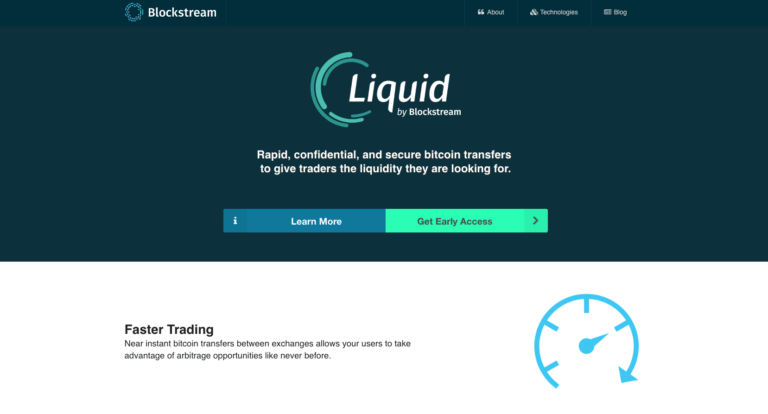On Wednesday (10 October 2018), Blockstream, which specializes in “sidechain” technology for Bitcoin, announced that the Liquid Network, “the world’s first production Bitcoin sidechain”, is now live.
A sidechain can be defined as “a blockchain ledger that runs in parallel to a primary blockchain. Entries from the primary blockchain can be linked to and from the sidechain; this allows the sidechain to otherwise operate independently of the primary blockchain (e.g., by using an alternate means of record keeping).”
Liquid is “an implementation of a federated sidechain – a private blockchain with different features, capabilities, and benefits than the main Bitcoin blockchain.” The Liquid Network was “built specifically to address the particular needs of exchanges and enables the rapid, confidential and secure transfer of funds between participants, providing a solution to the inherent problem of delayed transaction finality on the Bitcoin network.” This sidechain is “built on top of the Elements code-base and uses Blockstream’s Strong Federations technology to support the 1-to-1 exchange of bitcoin between chains.”
According to Blockstream, these are the main benefits of Liquid:
- “Faster Trading – Near instant bitcoin transfers between exchanges allow your users to take advantage of arbitrage opportunities like never before.”
- “Enhanced Efficiency – Market makers can improve their capital efficiency by reducing balances held across multiple exchanges.”
- “Verifiable Sidechains – Every Liquid transaction is real bitcoin, pegged via a sidechain to the Bitcoin blockchain, so you’re always dealing with real, verifiable assets.” (“All Liquid users can ensure that the amount of bitcoins inside of the Liquid Network is identical to the amount of bitcoins frozen in the main chain.”)
- “Better Privacy – Liquid supports Confidential Transactions for bitcoin amounts transferred in the system, which protects your users from exposure.”
- “Superb Reliability – Built using the battle tested Bitcoin code-base, Liquid software is highly reliable. Also, since Liquid uses signed blocks instead of mining, blocks are always one minute apart instead of an unknown amount of time like Bitcoin.”
Blockstream says that end users of participating crypto exchanges “never need to directly access the Liquid Network or hold bitcoins on the Liquid Network”:
“Exchanges that are members of the Liquid Network have the ability to send bitcoins to other participating exchanges through the Liquid Network. They can then do this on behalf of customers to send money between different exchanges. First a customer would request a deposit address from the destination exchange. This address would be similar to a Bitcoin address but begin with the letters CT. The end user would then take this address to the source exchange and request a withdrawal from that exchange and enter the destination address. The source exchange would then send bitcoins through the Liquid Network to the other exchange who would wait for confirmations of the deposit and credit your account.”
This is how Bitcoin exchanges/businesses and their customers benefit from Liquid:
“The participating exchanges and Bitcoin businesses deploy the software and hardware that make up the Liquid network, so that they can peg in and out of the Bitcoin blockchain and offer Liquid’s features to their traders. Liquid provides a more secure and efficient system for exchange-side bitcoin to move across the network. End users benefit from the greater liquidity Liquid enables between exchanges.”
And if you are wondering how Liquid is different from the Lightning Network, Blockstream has the answer:
“The Liquid sidechain is purpose-built to cater for the needs of exchanges, brokers and traders, enabling the rapid, secure and confidential transfers of large amounts of bitcoin between participants. The use of a blockchain allows for transfers to be made that are not bound by such things as a single user’s channel capacity. Transaction finality is assured once a transaction is included within a block and there is no risk of chain reorganization due to the process of Strong Federation block signing. Transactions are therefore not subject to delay due to the lack of cooperation of other parties. Funds in the sidechain can be increased by member exchanges pegging more bitcoin into the sidechain.
The Lightning Network is designed to enable the near-instant transfer of small or micro value payments between linked channel members and merchants. Transactions are limited in amount to channel capacity, specifically the capacity of the smallest channel in the ‘hops’ from sender to receiver. This means that there are cases where you may wish to send bitcoin through Lightning and a new channel would need to be created. This would require a new on-chain transaction in the Bitcoin network. To reduce the risk of monetary losses, the current maximum channel capacity is currently limited by the protocol to around 0.168 BTC. Transfers on the Lightning Network can also experience delays if a payment must route through parties that are not on-line, resulting in the potential need to open a new channel in order to route around them.”
Is Liquid as decentralized as Bitcoin? No, it is not, but as Blockstream explains, this is not as bad you might think:
“Liquid is a federated sidechain, so it will never be as decentralized as Bitcoin. However, Liquid is designed to remove control from any single party, geographic location, or political jurisdiction. The Liquid Network is operated by functionary servers, each securely hosted by geographically dispersed, independently owned and operated Bitcoin exchanges. Updates are deployed by consensus of participants within the network. No single party, including Blockstream, can control the Liquid network, and furthermore, no single entity is in control of more than a single Liquid functionary server.”
Although theoretically the architecture of Liquid allows it to support many types of assets, in this initial version of Liquid, the only asset supported is Bitcoin (BTC).
The blog post written by Samson Mow, the Chief Strategy Officer (CSO) at Blockstream, to announce the launch of Liquid provides the following details:
- “The Liquid blockchain went live with the first block generated on September 27, 2018 at 1:29 UTC. 23 of the cryptocurrency industry’s biggest players participated in the launch as Liquid members, including Altonomy, Atlantic Financial, Bitbank, Bitfinex, Bitmax, BitMEX, Bitso, BTCBOX, BTSE, Buull Exchange, DGroup, Coinone, Crypto Garage, GOPAX (operated by Streami), Korbit, L2B Global, OKCoin, The Rock Trading, SIX Digital Exchange, Unocoin, Xapo, XBTO, and Zaif.”
- “Liquid’s native Liquid Bitcoin (L-BTC) asset is backed by a two-way peg to Bitcoin (BTC) and can be redeemed at any time, providing institutions and end users with a secure and rapid way to transfer bitcoin between members with full settlement in two minutes.”
- “Liquid’s Issued Assets brings bitcoin-like features to traditional assets, such as tokenized fiat, digital reward points, and attested assets (e.g. gold coins), removing the need for dedicated blockchains or wallet software.”
- “Blockstream’s Confidential Transaction technology ensures that the amount and asset type transferred are known only to the transacting parties, enhancing the privacy of both L-BTC and Issued Asset transactions.”
The Blockstream CSO says this launch is just the beginning, and that there are “numerous features and applications in the works to expand participation.” Here are a few examples of what lies ahead: “GreenAddress wallet integration, an all-new open-source Liquid Wallet client, and plans for third-party hardware wallet support from Ledger and Trezor.”
Here are a couple of the more interesting reactions from Crypto-Twitter to today’s launch:
- Alistarir Milne, CIO at Altana Digital Currency Fund
Bitcoin Sidechains are herehttps://t.co/MzOEn6E8Cq
… and all exchanges should support it ASAP— Alistair Milne (@alistairmilne) October 10, 2018
- Bitcoin advocate/entrepreneur Matt Odell
All your favorite features from your centralized chain of choice, bolted on top of bitcoin, no token or ICO required.
“Liquid is sidechain built on the Bitcoin network, facilitating faster bitcoin transactions between businesses and individuals”https://t.co/JcYfhswisu pic.twitter.com/xpWdH6T0p4
— Matt Odell (@matt_odell) October 10, 2018
Featured Image Courtesy of Blockstream








